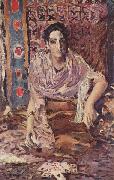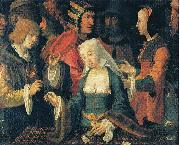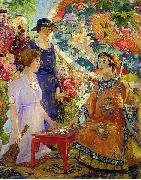
|
Mikhail Vrubel
|
|||
|
|
|||
| Russian Symbolist Painter, 1856-1910 Russian painter and draughtsman. He was a pioneer of modernism, and his highly innovative technique broke with the traditions of the Academy of Arts in St Petersburg, where he had been a brilliant student; at the same time he felt dissociated from the social consciousness of The Wanderers. | |||
|
|
|||
|
Fortune teller new21/Mikhail Vrubel-582625.jpg Painting ID:: 61530 |
Fortune teller 1895 | ||
|
|
|||
|
Lucas van Leyden
|
|||
|
|
|||
| 1489-1533 Dutch Lucas van Leyden Galleries Lucas van Leyden (Leiden, 1494 ?C August 8, 1533 in Leiden), also named either Lucas Hugensz or Lucas Jacobsz, was a Dutch engraver and painter, born and mainly active in Leiden, who was among the first Dutch exponents of genre painting and is generally regarded as one of the finest engravers in the history of art. He was the pupil of his father, from whose hand no works are known, and of Cornelis Engelbrechtsz, but both of these were painters whereas Lucas himself was principally an engraver. Where he learnt engraving is unknown, but he was highly skilled in that art at a very early age: the earliest known print by him (Mohammed and the Murdered Monk) dates from 1508, when he was perhaps only 14, yet reveals no trace of immaturity in inspiration or technique. Lot and his daughters (ca. 1509)In 1514 he entered the Painters' Guild at Leiden. He seems to have travelled a certain amount, and visits are recorded to Antwerp in 1521, the year of D??rer's Netherlandish journey, and to Middelburg in 1527, when he met Jan Mabuse. An unbroken series of dated engravings makes it possible to follow his career as a print-maker and to date many of his paintings, but no clear pattern of stylistic development emerges. D??rer was the single greatest influence on him, but Lucas was less intellectual in his approach, tending to concentrate on the anecdotal features of the subject and to take delight in caricatures and genre motifs. Carel van Mander characterizes Lucas as a pleasure-loving dilettante, who sometimes worked in bed, but he left a large oeuvre, in spite of his fairly early death, and must have been a prodigious worker. Lucas had a great reputation in his day (Vasari even rated him above D??rer) and is universally regarded as one of the greatest figures in the history of graphic art (he made etchings and woodcuts as well as engravings and was a prolific draughtsman). His status as a painter is less elevated, but he was undoubtedly one of the outstanding Netherlandish painters of his period. He was a pioneer of the Netherlandish genre tradition, as witness his Chess Players (Gemäldegalerie, Berlin) which actually represents a variant game called 'courier' - and his Card Players (National Gallery of Art, Washington), while his celebrated Last Judgement triptych (Lakenhal Museum, Leiden, 1526-27) shows the heights to which he could rise as a religious painter. It eloquently displays his vivid imaginative powers, his marvellous skill as a colourist and his deft and fluid brushwork. | |||
|
|
|||
|
fortune teller new24/Lucas van Leyden-988778.jpg Painting ID:: 73621 |
Date ca. 1508 (1508-1510) Medium Oil on panel Dimensions 24 X 30.5 cm (9.45 X 12.01 in) cyf | ||
|
|
|||
|
Colin Campbell Cooper
|
|||
|
|
|||
| 1856-1937 Colin Campbell Cooper Galleries Cooper was born in Philadelphia, Pennsylvania to Dr. Colin Campbell Cooper and Emily William Cooper. He studied art at the Pennsylvania Academy of the Fine Arts under Thomas Eakins, and at Acad??mie Julian in Paris. Back in Philadelphia, he taught watercolor classes at the Drexel Institute of Art, Science and Industry (now Drexel University). In 1897 he married renowned artist Emma Lampert, and the next year they moved to New York City, where he began work on his famous skyscraper paintings. He travelled extensively, sketching and painting scenes of Europe, Asia, and the United States in watercolors and oils. He and his wife were on the RMS Carpathia and assisted in the rescue of the survivors of the Titanic. Several of his paintings document the rescue. In 1912, Cooper was elected to a prestigious membership in the National Academy of Design. Cooper exhibited in San Francisco's Panama-Pacific Exposition of 1915, winning the Gold Medal for oil and the Silver Medal for watercolor. He also participated in the Panama-California Exposition in San Diego. In 1920 his wife Emma died. He moved to Santa Barbara, California in 1921 and became dean of the School of Painting at the Santa Barbara Community School of Arts. He married his second wife, Marie Frehsee, in 1927. Cooper died in Santa Barbara in 1937. | |||
|
|
|||
|
Fortune Teller new25/Colin Campbell Cooper-593937.jpg Painting ID:: 89171 |
oil on canvas, 46 x 36.25 in Date 1921(1921) cjr | ||
|
|
|||
|
Theo van Doesburg
|
|||
|
|
|||
| Dutch 1883-1931 Dutch painter, architect, designer and writer. He was officially registered as the son of Wilhelm Kepper and Henrietta Catharina Margadant, but he was so convinced that his mother second husband, Theodorus Doesburg, was his father that he took his name. Little is known of his early life, but he began painting naturalistic subjects c. 1899. In 1903 he began his military service, and around the same time he met his first wife, Agnita Feis, a Theosophist and poet. Between about 1908 and 1910, much influenced by the work of Honor Daumier, he produced caricatures, some of which were later published in his first book De maskers af! (1916). Also during this period he painted some Impressionist-inspired landscapes and portraits in the manner of George Hendrik Breitner. Between 1914 and 1915 the influence of Kandinsky became clear in such drawings as Streetmusic I and Streetmusic II (The Hague, Rijksdienst Beeld. Kst) and other abstract works. | |||
|
|
|||
|
Fortune Teller new25/Theo van Doesburg-867547.jpg Painting ID:: 92977 |
Litografie op papier. 10,5 X 10,5 cm 1910 TTD | ||
|
|
|||
|
Georges de La Tour
|
|||
|
|
|||
| 1593-1652 French Georges de La Tour Galleries His early work shows influences from Caravaggio, probably via his Dutch followers, and the genre scenes of cheats??as in The Fortune Teller ??and fighting beggars clearly derive from the Dutch Caravaggisti, and probably also his fellow-Lorrainer, Jacques Bellange. These are believed to date from relatively early in his career. La Tour is best known for the nocturnal light effects which he developed much further than his artistic predecessors had done, and transferred their use in the genre subjects in the paintings of the Dutch Caravaggisti to religious painting in his. Unlike Caravaggio his religious paintings lack dramatic effects. He painted these in a second phase of his style, perhaps beginning in the 1640s, using chiaroscuro, careful geometrical compositions, and very simplified painting of forms. His work moves during his career towards greater simplicity and stillness ?? taking from Caravaggio very different qualities than Jusepe de Ribera and his Tenebrist followers did. He often painted several variations on the same subjects, and his surviving output is relatively small. His son Etienne was his pupil, and distinguishing between their work in versions of La Tour's compositions is difficult. The version of the Education of the Virgin, in the Frick Collection in New York is an example, as the Museum itself admits. Another group of paintings (example left), of great skill but claimed to be different in style to those of de La Tour, have been attributed to an unknown "Hurdy-gurdy Master". All show older male figures (one group in Malibu includes a female), mostly solitary, either beggars or saints. After his death in 1652, La Tour's work was largely forgotten until rediscovered by Hermann Voss, a German scholar, in 1915. In 1935 an exhibition in Paris began the revival in interest among a wider public. In the twentieth century a number of his works were identified once more, and forgers tried to help meet the new demand; many aspects of his œuvre remain controversial among art historians. | |||
|
|
|||
|
Fortune Teller new26/Georges de La Tour-439794.jpg Painting ID:: 94819 |
1630 Type Oil painting Dimensions 101.9 cm x 123.5 cm cyf | ||
|
|
|||
|
Also Buy::. For Following Paintings / Artists / Products, Please Use Our Search Online: |












